Impact of Whey Protein on Digestive System
VerifiedAdded on 2023/04/21
|9
|2125
|233
AI Summary
This article explores the impact of whey protein on the digestive system. It discusses how whey protein improves digestion and helps with lactose intolerance. It also provides information on the potential benefits and effectiveness of whey protein in various health conditions.
Contribute Materials
Your contribution can guide someone’s learning journey. Share your
documents today.

Video Presentation
Student’s Name:
Student’s ID:
Student’s Name:
Student’s ID:
Secure Best Marks with AI Grader
Need help grading? Try our AI Grader for instant feedback on your assignments.
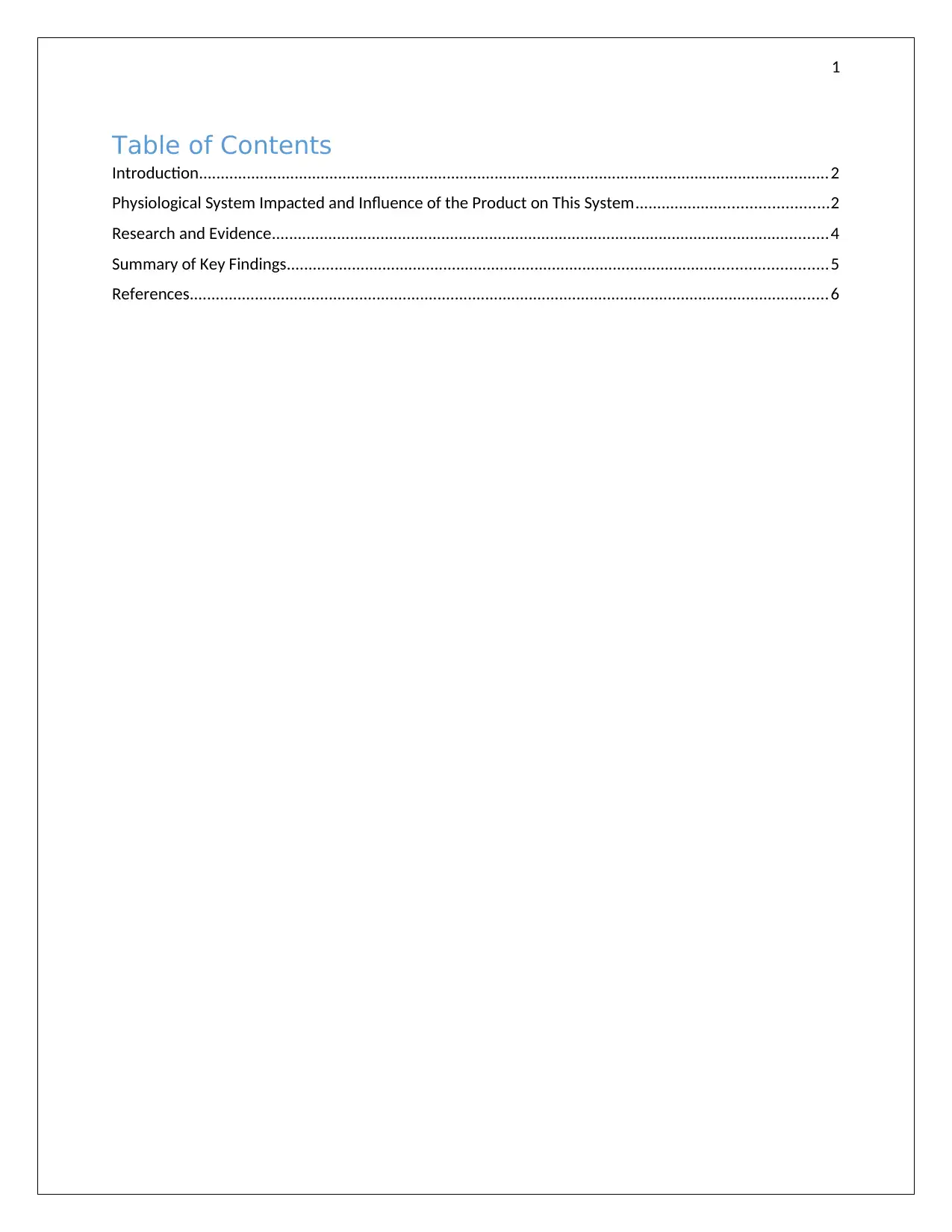
1
Table of Contents
Introduction.................................................................................................................................................2
Physiological System Impacted and Influence of the Product on This System............................................2
Research and Evidence................................................................................................................................4
Summary of Key Findings............................................................................................................................5
References...................................................................................................................................................6
Table of Contents
Introduction.................................................................................................................................................2
Physiological System Impacted and Influence of the Product on This System............................................2
Research and Evidence................................................................................................................................4
Summary of Key Findings............................................................................................................................5
References...................................................................................................................................................6
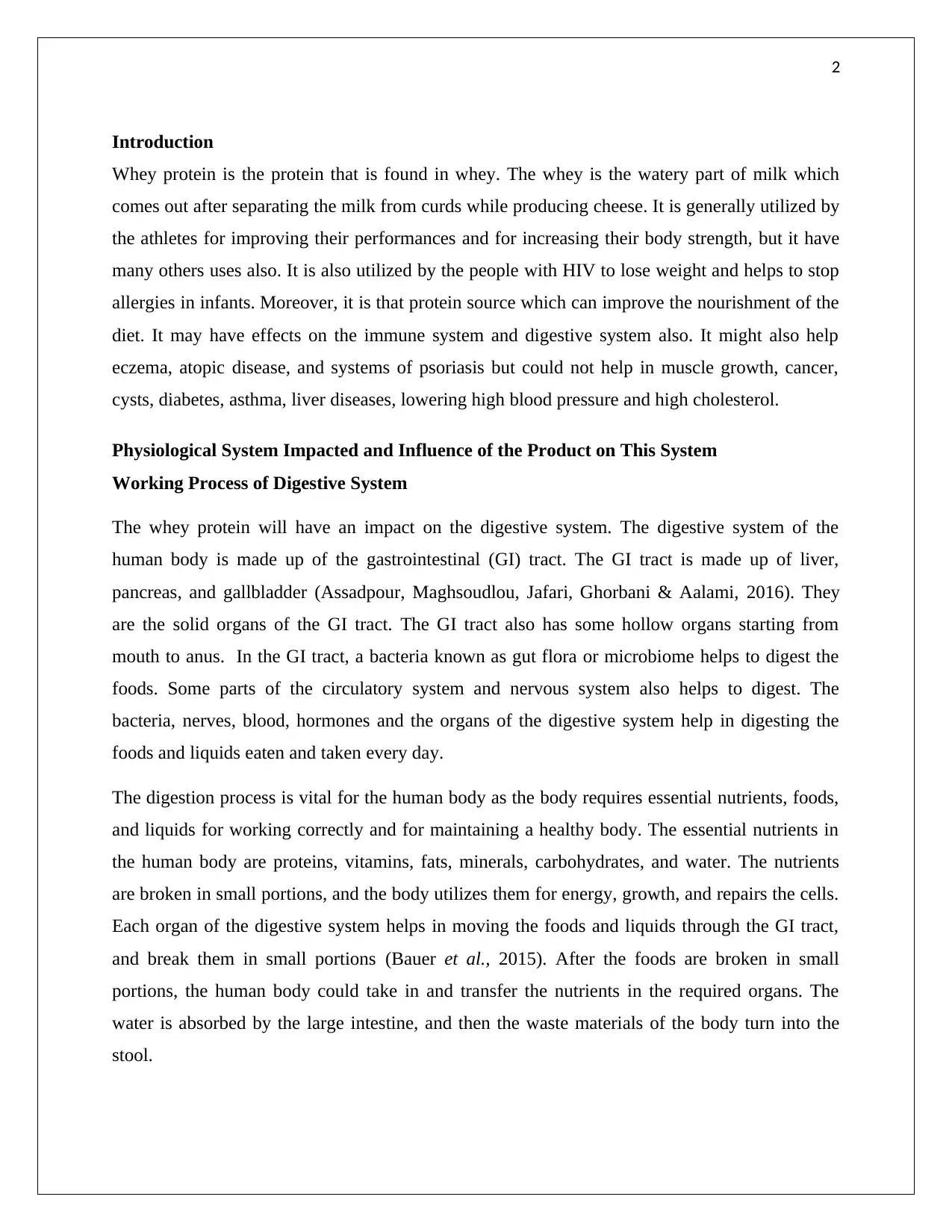
2
Introduction
Whey protein is the protein that is found in whey. The whey is the watery part of milk which
comes out after separating the milk from curds while producing cheese. It is generally utilized by
the athletes for improving their performances and for increasing their body strength, but it have
many others uses also. It is also utilized by the people with HIV to lose weight and helps to stop
allergies in infants. Moreover, it is that protein source which can improve the nourishment of the
diet. It may have effects on the immune system and digestive system also. It might also help
eczema, atopic disease, and systems of psoriasis but could not help in muscle growth, cancer,
cysts, diabetes, asthma, liver diseases, lowering high blood pressure and high cholesterol.
Physiological System Impacted and Influence of the Product on This System
Working Process of Digestive System
The whey protein will have an impact on the digestive system. The digestive system of the
human body is made up of the gastrointestinal (GI) tract. The GI tract is made up of liver,
pancreas, and gallbladder (Assadpour, Maghsoudlou, Jafari, Ghorbani & Aalami, 2016). They
are the solid organs of the GI tract. The GI tract also has some hollow organs starting from
mouth to anus. In the GI tract, a bacteria known as gut flora or microbiome helps to digest the
foods. Some parts of the circulatory system and nervous system also helps to digest. The
bacteria, nerves, blood, hormones and the organs of the digestive system help in digesting the
foods and liquids eaten and taken every day.
The digestion process is vital for the human body as the body requires essential nutrients, foods,
and liquids for working correctly and for maintaining a healthy body. The essential nutrients in
the human body are proteins, vitamins, fats, minerals, carbohydrates, and water. The nutrients
are broken in small portions, and the body utilizes them for energy, growth, and repairs the cells.
Each organ of the digestive system helps in moving the foods and liquids through the GI tract,
and break them in small portions (Bauer et al., 2015). After the foods are broken in small
portions, the human body could take in and transfer the nutrients in the required organs. The
water is absorbed by the large intestine, and then the waste materials of the body turn into the
stool.
Introduction
Whey protein is the protein that is found in whey. The whey is the watery part of milk which
comes out after separating the milk from curds while producing cheese. It is generally utilized by
the athletes for improving their performances and for increasing their body strength, but it have
many others uses also. It is also utilized by the people with HIV to lose weight and helps to stop
allergies in infants. Moreover, it is that protein source which can improve the nourishment of the
diet. It may have effects on the immune system and digestive system also. It might also help
eczema, atopic disease, and systems of psoriasis but could not help in muscle growth, cancer,
cysts, diabetes, asthma, liver diseases, lowering high blood pressure and high cholesterol.
Physiological System Impacted and Influence of the Product on This System
Working Process of Digestive System
The whey protein will have an impact on the digestive system. The digestive system of the
human body is made up of the gastrointestinal (GI) tract. The GI tract is made up of liver,
pancreas, and gallbladder (Assadpour, Maghsoudlou, Jafari, Ghorbani & Aalami, 2016). They
are the solid organs of the GI tract. The GI tract also has some hollow organs starting from
mouth to anus. In the GI tract, a bacteria known as gut flora or microbiome helps to digest the
foods. Some parts of the circulatory system and nervous system also helps to digest. The
bacteria, nerves, blood, hormones and the organs of the digestive system help in digesting the
foods and liquids eaten and taken every day.
The digestion process is vital for the human body as the body requires essential nutrients, foods,
and liquids for working correctly and for maintaining a healthy body. The essential nutrients in
the human body are proteins, vitamins, fats, minerals, carbohydrates, and water. The nutrients
are broken in small portions, and the body utilizes them for energy, growth, and repairs the cells.
Each organ of the digestive system helps in moving the foods and liquids through the GI tract,
and break them in small portions (Bauer et al., 2015). After the foods are broken in small
portions, the human body could take in and transfer the nutrients in the required organs. The
water is absorbed by the large intestine, and then the waste materials of the body turn into the
stool.
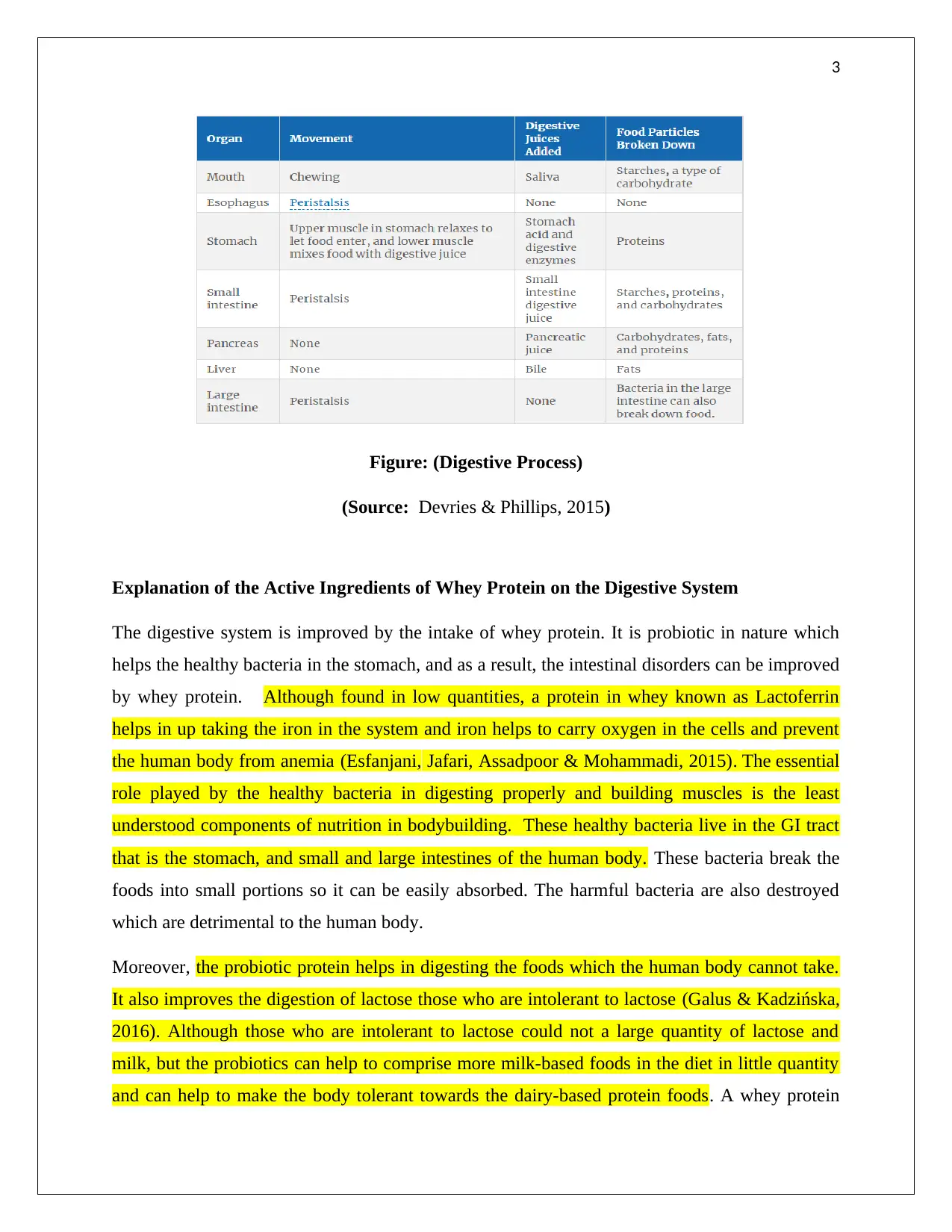
3
Figure: (Digestive Process)
(Source: Devries & Phillips, 2015)
Explanation of the Active Ingredients of Whey Protein on the Digestive System
The digestive system is improved by the intake of whey protein. It is probiotic in nature which
helps the healthy bacteria in the stomach, and as a result, the intestinal disorders can be improved
by whey protein. Although found in low quantities, a protein in whey known as Lactoferrin
helps in up taking the iron in the system and iron helps to carry oxygen in the cells and prevent
the human body from anemia (Esfanjani, Jafari, Assadpoor & Mohammadi, 2015). The essential
role played by the healthy bacteria in digesting properly and building muscles is the least
understood components of nutrition in bodybuilding. These healthy bacteria live in the GI tract
that is the stomach, and small and large intestines of the human body. These bacteria break the
foods into small portions so it can be easily absorbed. The harmful bacteria are also destroyed
which are detrimental to the human body.
Moreover, the probiotic protein helps in digesting the foods which the human body cannot take.
It also improves the digestion of lactose those who are intolerant to lactose (Galus & Kadzińska,
2016). Although those who are intolerant to lactose could not a large quantity of lactose and
milk, but the probiotics can help to comprise more milk-based foods in the diet in little quantity
and can help to make the body tolerant towards the dairy-based protein foods. A whey protein
Figure: (Digestive Process)
(Source: Devries & Phillips, 2015)
Explanation of the Active Ingredients of Whey Protein on the Digestive System
The digestive system is improved by the intake of whey protein. It is probiotic in nature which
helps the healthy bacteria in the stomach, and as a result, the intestinal disorders can be improved
by whey protein. Although found in low quantities, a protein in whey known as Lactoferrin
helps in up taking the iron in the system and iron helps to carry oxygen in the cells and prevent
the human body from anemia (Esfanjani, Jafari, Assadpoor & Mohammadi, 2015). The essential
role played by the healthy bacteria in digesting properly and building muscles is the least
understood components of nutrition in bodybuilding. These healthy bacteria live in the GI tract
that is the stomach, and small and large intestines of the human body. These bacteria break the
foods into small portions so it can be easily absorbed. The harmful bacteria are also destroyed
which are detrimental to the human body.
Moreover, the probiotic protein helps in digesting the foods which the human body cannot take.
It also improves the digestion of lactose those who are intolerant to lactose (Galus & Kadzińska,
2016). Although those who are intolerant to lactose could not a large quantity of lactose and
milk, but the probiotics can help to comprise more milk-based foods in the diet in little quantity
and can help to make the body tolerant towards the dairy-based protein foods. A whey protein
Secure Best Marks with AI Grader
Need help grading? Try our AI Grader for instant feedback on your assignments.
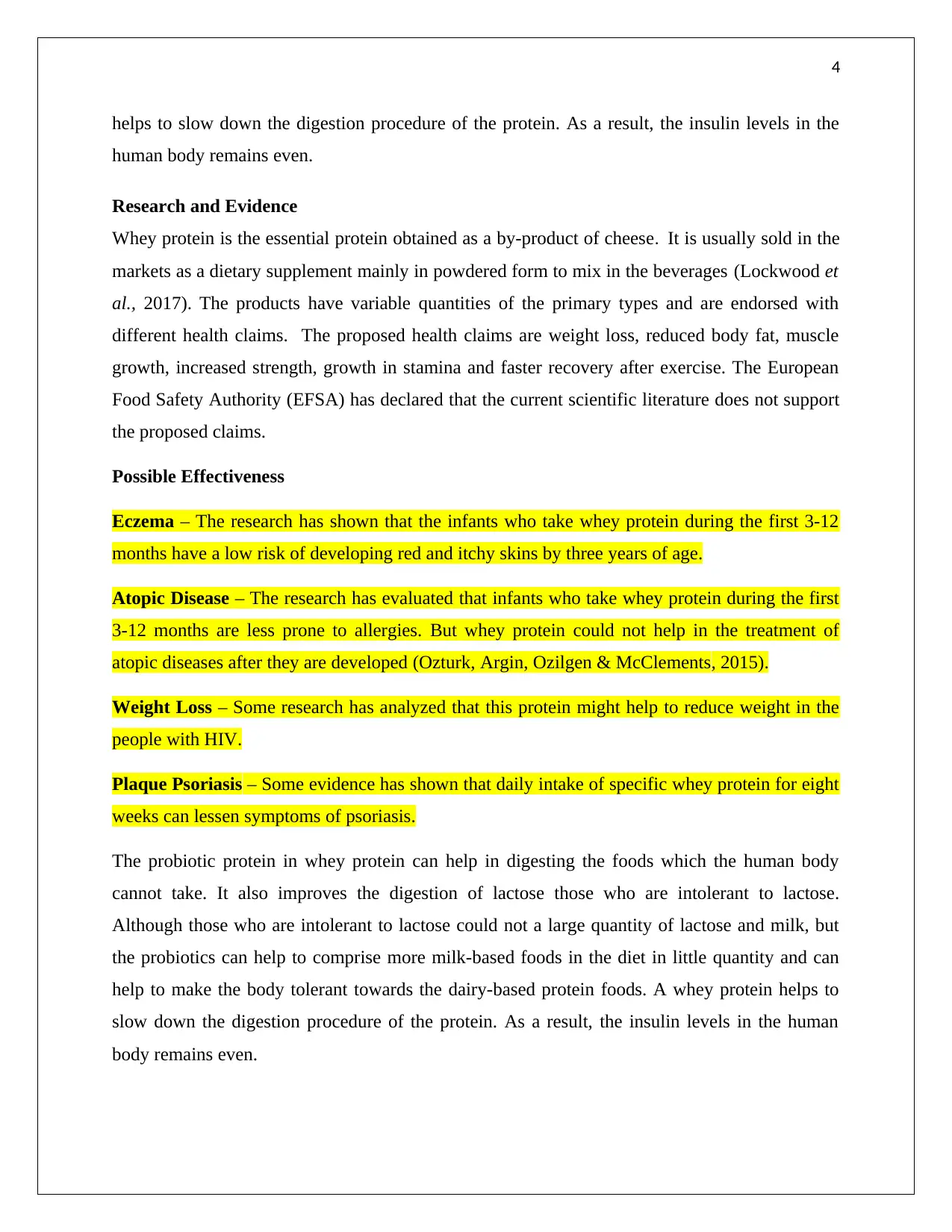
4
helps to slow down the digestion procedure of the protein. As a result, the insulin levels in the
human body remains even.
Research and Evidence
Whey protein is the essential protein obtained as a by-product of cheese. It is usually sold in the
markets as a dietary supplement mainly in powdered form to mix in the beverages (Lockwood et
al., 2017). The products have variable quantities of the primary types and are endorsed with
different health claims. The proposed health claims are weight loss, reduced body fat, muscle
growth, increased strength, growth in stamina and faster recovery after exercise. The European
Food Safety Authority (EFSA) has declared that the current scientific literature does not support
the proposed claims.
Possible Effectiveness
Eczema – The research has shown that the infants who take whey protein during the first 3-12
months have a low risk of developing red and itchy skins by three years of age.
Atopic Disease – The research has evaluated that infants who take whey protein during the first
3-12 months are less prone to allergies. But whey protein could not help in the treatment of
atopic diseases after they are developed (Ozturk, Argin, Ozilgen & McClements, 2015).
Weight Loss – Some research has analyzed that this protein might help to reduce weight in the
people with HIV.
Plaque Psoriasis – Some evidence has shown that daily intake of specific whey protein for eight
weeks can lessen symptoms of psoriasis.
The probiotic protein in whey protein can help in digesting the foods which the human body
cannot take. It also improves the digestion of lactose those who are intolerant to lactose.
Although those who are intolerant to lactose could not a large quantity of lactose and milk, but
the probiotics can help to comprise more milk-based foods in the diet in little quantity and can
help to make the body tolerant towards the dairy-based protein foods. A whey protein helps to
slow down the digestion procedure of the protein. As a result, the insulin levels in the human
body remains even.
helps to slow down the digestion procedure of the protein. As a result, the insulin levels in the
human body remains even.
Research and Evidence
Whey protein is the essential protein obtained as a by-product of cheese. It is usually sold in the
markets as a dietary supplement mainly in powdered form to mix in the beverages (Lockwood et
al., 2017). The products have variable quantities of the primary types and are endorsed with
different health claims. The proposed health claims are weight loss, reduced body fat, muscle
growth, increased strength, growth in stamina and faster recovery after exercise. The European
Food Safety Authority (EFSA) has declared that the current scientific literature does not support
the proposed claims.
Possible Effectiveness
Eczema – The research has shown that the infants who take whey protein during the first 3-12
months have a low risk of developing red and itchy skins by three years of age.
Atopic Disease – The research has evaluated that infants who take whey protein during the first
3-12 months are less prone to allergies. But whey protein could not help in the treatment of
atopic diseases after they are developed (Ozturk, Argin, Ozilgen & McClements, 2015).
Weight Loss – Some research has analyzed that this protein might help to reduce weight in the
people with HIV.
Plaque Psoriasis – Some evidence has shown that daily intake of specific whey protein for eight
weeks can lessen symptoms of psoriasis.
The probiotic protein in whey protein can help in digesting the foods which the human body
cannot take. It also improves the digestion of lactose those who are intolerant to lactose.
Although those who are intolerant to lactose could not a large quantity of lactose and milk, but
the probiotics can help to comprise more milk-based foods in the diet in little quantity and can
help to make the body tolerant towards the dairy-based protein foods. A whey protein helps to
slow down the digestion procedure of the protein. As a result, the insulin levels in the human
body remains even.
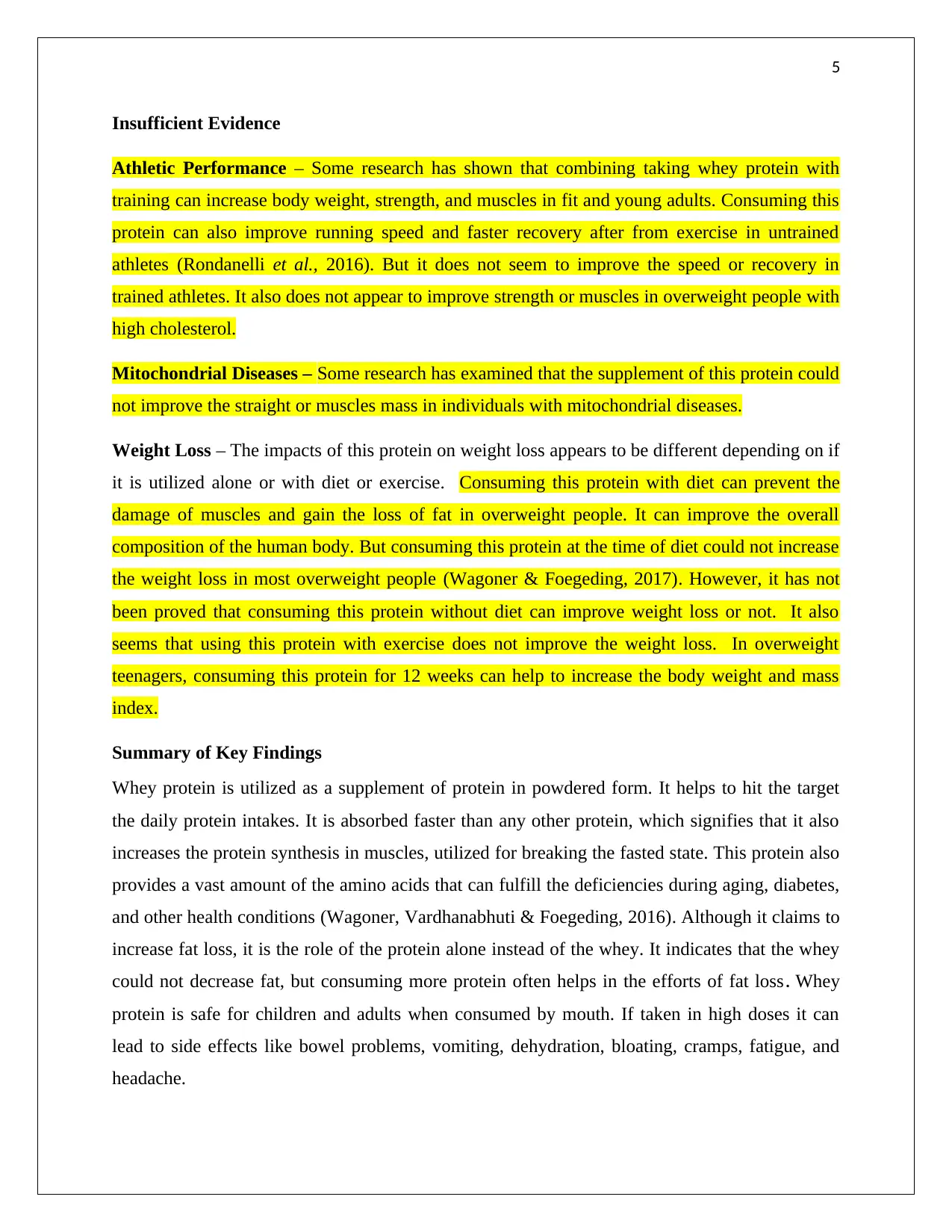
5
Insufficient Evidence
Athletic Performance – Some research has shown that combining taking whey protein with
training can increase body weight, strength, and muscles in fit and young adults. Consuming this
protein can also improve running speed and faster recovery after from exercise in untrained
athletes (Rondanelli et al., 2016). But it does not seem to improve the speed or recovery in
trained athletes. It also does not appear to improve strength or muscles in overweight people with
high cholesterol.
Mitochondrial Diseases – Some research has examined that the supplement of this protein could
not improve the straight or muscles mass in individuals with mitochondrial diseases.
Weight Loss – The impacts of this protein on weight loss appears to be different depending on if
it is utilized alone or with diet or exercise. Consuming this protein with diet can prevent the
damage of muscles and gain the loss of fat in overweight people. It can improve the overall
composition of the human body. But consuming this protein at the time of diet could not increase
the weight loss in most overweight people (Wagoner & Foegeding, 2017). However, it has not
been proved that consuming this protein without diet can improve weight loss or not. It also
seems that using this protein with exercise does not improve the weight loss. In overweight
teenagers, consuming this protein for 12 weeks can help to increase the body weight and mass
index.
Summary of Key Findings
Whey protein is utilized as a supplement of protein in powdered form. It helps to hit the target
the daily protein intakes. It is absorbed faster than any other protein, which signifies that it also
increases the protein synthesis in muscles, utilized for breaking the fasted state. This protein also
provides a vast amount of the amino acids that can fulfill the deficiencies during aging, diabetes,
and other health conditions (Wagoner, Vardhanabhuti & Foegeding, 2016). Although it claims to
increase fat loss, it is the role of the protein alone instead of the whey. It indicates that the whey
could not decrease fat, but consuming more protein often helps in the efforts of fat loss. Whey
protein is safe for children and adults when consumed by mouth. If taken in high doses it can
lead to side effects like bowel problems, vomiting, dehydration, bloating, cramps, fatigue, and
headache.
Insufficient Evidence
Athletic Performance – Some research has shown that combining taking whey protein with
training can increase body weight, strength, and muscles in fit and young adults. Consuming this
protein can also improve running speed and faster recovery after from exercise in untrained
athletes (Rondanelli et al., 2016). But it does not seem to improve the speed or recovery in
trained athletes. It also does not appear to improve strength or muscles in overweight people with
high cholesterol.
Mitochondrial Diseases – Some research has examined that the supplement of this protein could
not improve the straight or muscles mass in individuals with mitochondrial diseases.
Weight Loss – The impacts of this protein on weight loss appears to be different depending on if
it is utilized alone or with diet or exercise. Consuming this protein with diet can prevent the
damage of muscles and gain the loss of fat in overweight people. It can improve the overall
composition of the human body. But consuming this protein at the time of diet could not increase
the weight loss in most overweight people (Wagoner & Foegeding, 2017). However, it has not
been proved that consuming this protein without diet can improve weight loss or not. It also
seems that using this protein with exercise does not improve the weight loss. In overweight
teenagers, consuming this protein for 12 weeks can help to increase the body weight and mass
index.
Summary of Key Findings
Whey protein is utilized as a supplement of protein in powdered form. It helps to hit the target
the daily protein intakes. It is absorbed faster than any other protein, which signifies that it also
increases the protein synthesis in muscles, utilized for breaking the fasted state. This protein also
provides a vast amount of the amino acids that can fulfill the deficiencies during aging, diabetes,
and other health conditions (Wagoner, Vardhanabhuti & Foegeding, 2016). Although it claims to
increase fat loss, it is the role of the protein alone instead of the whey. It indicates that the whey
could not decrease fat, but consuming more protein often helps in the efforts of fat loss. Whey
protein is safe for children and adults when consumed by mouth. If taken in high doses it can
lead to side effects like bowel problems, vomiting, dehydration, bloating, cramps, fatigue, and
headache.

6
Paraphrase This Document
Need a fresh take? Get an instant paraphrase of this document with our AI Paraphraser
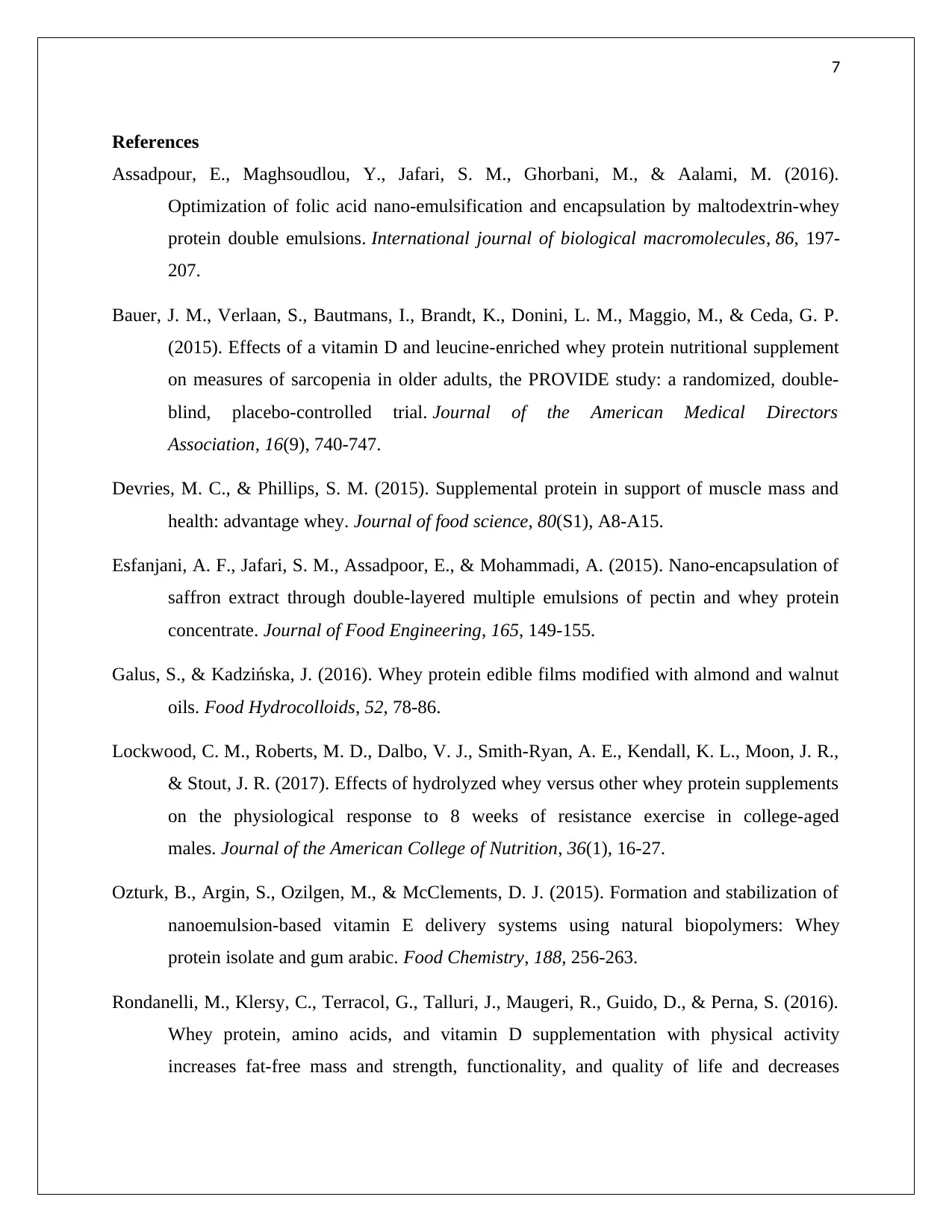
7
References
Assadpour, E., Maghsoudlou, Y., Jafari, S. M., Ghorbani, M., & Aalami, M. (2016).
Optimization of folic acid nano-emulsification and encapsulation by maltodextrin-whey
protein double emulsions. International journal of biological macromolecules, 86, 197-
207.
Bauer, J. M., Verlaan, S., Bautmans, I., Brandt, K., Donini, L. M., Maggio, M., & Ceda, G. P.
(2015). Effects of a vitamin D and leucine-enriched whey protein nutritional supplement
on measures of sarcopenia in older adults, the PROVIDE study: a randomized, double-
blind, placebo-controlled trial. Journal of the American Medical Directors
Association, 16(9), 740-747.
Devries, M. C., & Phillips, S. M. (2015). Supplemental protein in support of muscle mass and
health: advantage whey. Journal of food science, 80(S1), A8-A15.
Esfanjani, A. F., Jafari, S. M., Assadpoor, E., & Mohammadi, A. (2015). Nano-encapsulation of
saffron extract through double-layered multiple emulsions of pectin and whey protein
concentrate. Journal of Food Engineering, 165, 149-155.
Galus, S., & Kadzińska, J. (2016). Whey protein edible films modified with almond and walnut
oils. Food Hydrocolloids, 52, 78-86.
Lockwood, C. M., Roberts, M. D., Dalbo, V. J., Smith-Ryan, A. E., Kendall, K. L., Moon, J. R.,
& Stout, J. R. (2017). Effects of hydrolyzed whey versus other whey protein supplements
on the physiological response to 8 weeks of resistance exercise in college-aged
males. Journal of the American College of Nutrition, 36(1), 16-27.
Ozturk, B., Argin, S., Ozilgen, M., & McClements, D. J. (2015). Formation and stabilization of
nanoemulsion-based vitamin E delivery systems using natural biopolymers: Whey
protein isolate and gum arabic. Food Chemistry, 188, 256-263.
Rondanelli, M., Klersy, C., Terracol, G., Talluri, J., Maugeri, R., Guido, D., & Perna, S. (2016).
Whey protein, amino acids, and vitamin D supplementation with physical activity
increases fat-free mass and strength, functionality, and quality of life and decreases
References
Assadpour, E., Maghsoudlou, Y., Jafari, S. M., Ghorbani, M., & Aalami, M. (2016).
Optimization of folic acid nano-emulsification and encapsulation by maltodextrin-whey
protein double emulsions. International journal of biological macromolecules, 86, 197-
207.
Bauer, J. M., Verlaan, S., Bautmans, I., Brandt, K., Donini, L. M., Maggio, M., & Ceda, G. P.
(2015). Effects of a vitamin D and leucine-enriched whey protein nutritional supplement
on measures of sarcopenia in older adults, the PROVIDE study: a randomized, double-
blind, placebo-controlled trial. Journal of the American Medical Directors
Association, 16(9), 740-747.
Devries, M. C., & Phillips, S. M. (2015). Supplemental protein in support of muscle mass and
health: advantage whey. Journal of food science, 80(S1), A8-A15.
Esfanjani, A. F., Jafari, S. M., Assadpoor, E., & Mohammadi, A. (2015). Nano-encapsulation of
saffron extract through double-layered multiple emulsions of pectin and whey protein
concentrate. Journal of Food Engineering, 165, 149-155.
Galus, S., & Kadzińska, J. (2016). Whey protein edible films modified with almond and walnut
oils. Food Hydrocolloids, 52, 78-86.
Lockwood, C. M., Roberts, M. D., Dalbo, V. J., Smith-Ryan, A. E., Kendall, K. L., Moon, J. R.,
& Stout, J. R. (2017). Effects of hydrolyzed whey versus other whey protein supplements
on the physiological response to 8 weeks of resistance exercise in college-aged
males. Journal of the American College of Nutrition, 36(1), 16-27.
Ozturk, B., Argin, S., Ozilgen, M., & McClements, D. J. (2015). Formation and stabilization of
nanoemulsion-based vitamin E delivery systems using natural biopolymers: Whey
protein isolate and gum arabic. Food Chemistry, 188, 256-263.
Rondanelli, M., Klersy, C., Terracol, G., Talluri, J., Maugeri, R., Guido, D., & Perna, S. (2016).
Whey protein, amino acids, and vitamin D supplementation with physical activity
increases fat-free mass and strength, functionality, and quality of life and decreases
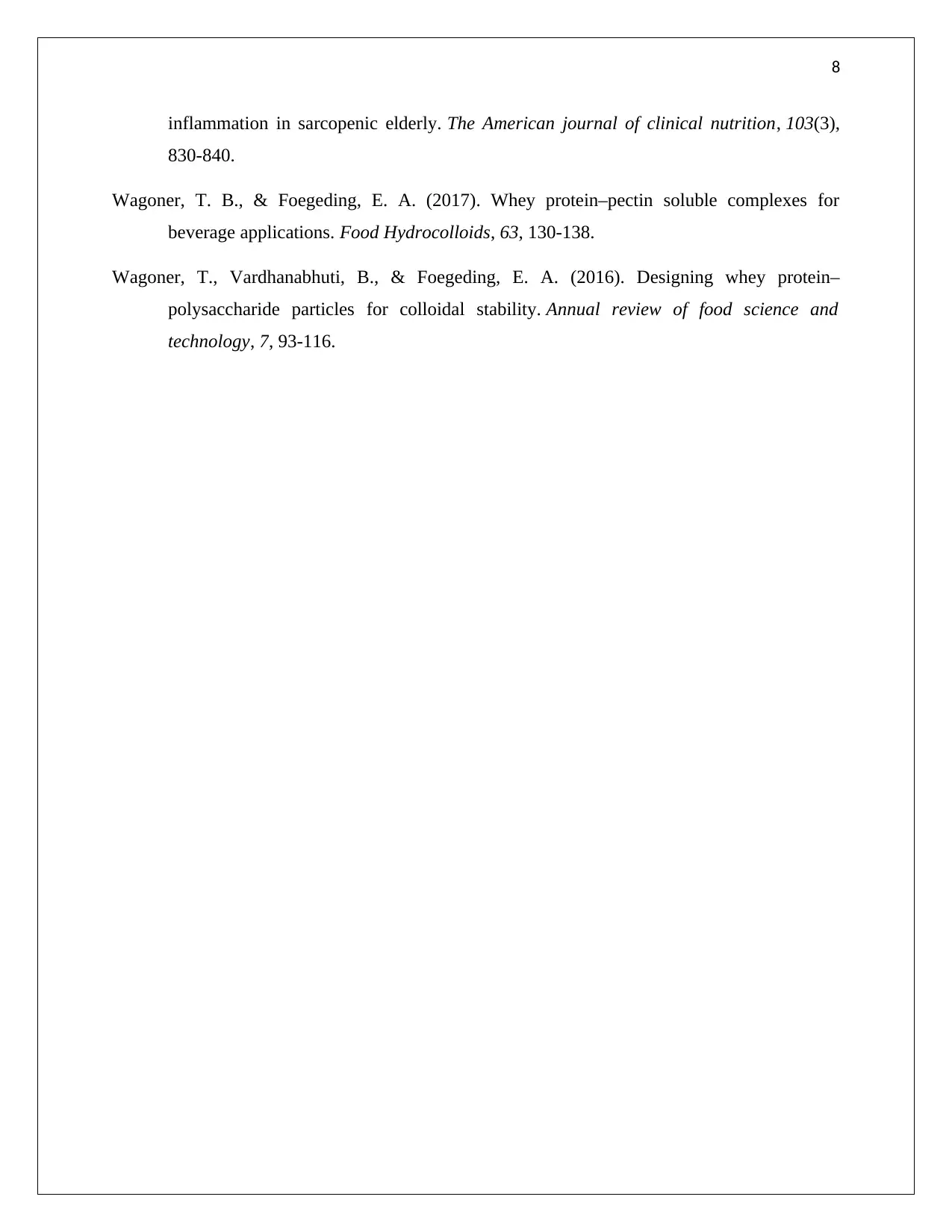
8
inflammation in sarcopenic elderly. The American journal of clinical nutrition, 103(3),
830-840.
Wagoner, T. B., & Foegeding, E. A. (2017). Whey protein–pectin soluble complexes for
beverage applications. Food Hydrocolloids, 63, 130-138.
Wagoner, T., Vardhanabhuti, B., & Foegeding, E. A. (2016). Designing whey protein–
polysaccharide particles for colloidal stability. Annual review of food science and
technology, 7, 93-116.
inflammation in sarcopenic elderly. The American journal of clinical nutrition, 103(3),
830-840.
Wagoner, T. B., & Foegeding, E. A. (2017). Whey protein–pectin soluble complexes for
beverage applications. Food Hydrocolloids, 63, 130-138.
Wagoner, T., Vardhanabhuti, B., & Foegeding, E. A. (2016). Designing whey protein–
polysaccharide particles for colloidal stability. Annual review of food science and
technology, 7, 93-116.
1 out of 9
Related Documents
Your All-in-One AI-Powered Toolkit for Academic Success.
+13062052269
info@desklib.com
Available 24*7 on WhatsApp / Email
![[object Object]](/_next/static/media/star-bottom.7253800d.svg)
Unlock your academic potential
© 2024 | Zucol Services PVT LTD | All rights reserved.





